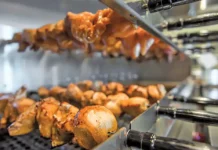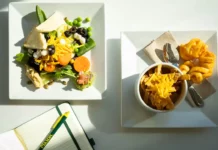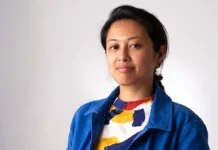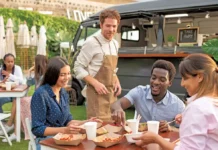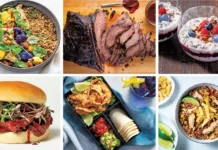Owner of Zafra and Cucharamama Restaurants, Hoboken NJ
So how did you get into the industry?
How did I get into the industry? Well, it was a chance meeting at a restaurant in Manhattan called The Ballroom It was owned by a very famous chef at the time. His name was Felipe Rojas-Lombardi. He had been an assistant of the great James Beard at his cooking school and was very well connected. He had opened the first tapas bar in the US with a cabaret where many great singers like Peggy Lee performed.
You know, famous and wonderful places in the city.
Yes. So I went there to visit my friend Montse Guillén, a Catalan chef from Barcelona who was working with Felipe on his tapas concept.
What were you doing at that time?
I was doing my thesis. I was working on my doctoral dissertation at New York University.
So you were at NYU. Masters, or, doctorate?
I was in NYU getting my doctorate in Medieval Spanish history, but I liked to cook for a lot of people so I had been asked to coordinate the food events of Catalan Week in New York to celebrate the new department of Catalan Language at NYU. It was during this week-long event that I met Montse and ended up meeting Felipe. The day I first visited The Ballroom, Felipe said “If you would like some training you can come here on your free day at the university.” That was Wednesday. So I did that and The Ballroom became my first professional kitchen. While working with Felipe in recipe development, I also met some of the movers and shakers of the industry, which led to everything else in my life – everything good happened in that kitchen.
So tell me what happened after that?
Well, what happened is that I began to develop a whole new profession. Frankly, I had started cooking as a hobby because I was doing research and it was all very intense. But eventually, it became a real all-consuming profession.
What was the subject of the thesis just out of curiosity?
It was about death in thirteenth-century Spain. It was about king Alfonso X of Castile, who compiled many treatises on science, history and law, and who had commissioned and written a collection of miracles of the Virgin Mary. My thesis was an historical study of how the image of death and salvation was presented and manipulated to serve both the political and spiritual aspirations of this great and learned king. Writing this thesis was a fascinating exercise. It had to do with art, poetry, and history. But as I was writing my thesis, I was also developing a parallel career. Out of that chance encounter at The Ballroom, I became very connected in the food world. In no time, I was already giving lectures on Latin American food. It did not take me long to realize that I knew more about Latin American food than a lot of professional food people here in the US so I took clear advantage of that and I began to like the food world. I thought it was exciting.
Where did all that knowledge come from?
My curiosity, the fact that I had always been interested in new things. I also came from a family of good cooks and I was very interested in what I ate; the history of what I ate. No doubt I had always been fascinated by Latin America and culinary history and had read a lot.
Now where did you grow up?
I grew up in Cuba, but I have been in the US for a while. I also travel a lot throughout Latin America. My favorite travel destinations are in Latin America and Spain where I lived as a student. So I was properly prepared.
Yes, I saw that, that was one of my questions that I had.
I was prepared to speak about Latin American food at a time when people were not prepared to embrace Latin American food just yet. I think that in a way I was a bit ahead of my time. Yes I really was.
Were you ahead of yourself in terms of flavor?
For example, I knew Latin American food was poised to become the next biggest thing in the US in the early ’80s. I saw it very clearly. I knew it would be an explosion and realized that the time was ready for us. I knew it with absolute conviction.
Now why did you feel that way? Did you feel it because of the flavor?
As you look at bland food, is it the flavor or is it the color or is it the texture? What are the things that you felt would blend them to the American palate?
I just knew it. I felt that North Americans and Latin Americans are very close; closer than we all think. Americans are also very curious people. I think if any nation in the world would be ready for Latin American food it was the US. Americans are inquisitive. They’re curious. They jump into things with a passion. Americans are self-critical. They’re willing to say: “we can try new foods.” Americans are like that, more than anybody else on the planet. And I understand their curiosity because I see it in my own customers. They are happier to taste and experience everything than even people from Latin America, who tend to have a more provincial way of looking at foods because they always go back to memories of the food they left behind and think it is the best. In contrast, for Americans everything is a feast. They explore everything with enormous pleasure. I think that the best that Americans bring to the table is an open mind, which I adore. We also have lots of educated and well-traveled Latin American customers who also think like Americans because they have been here for quite a while. What I love most about my customers is an open mind.
When you lived in Spain what did you find different in terms of how they cook and what they cook?
I would eat in very popular places and cooked a lot at home. I loved their fresh ingredients —fruits, vegetables, seafood– and I soon realized that the greatness of Spanish cooking was not in elaborate preparations, but it was rooted in excellent ingredients. I mean if you ate lamb, it was an incredible lamb, if you had artichokes, they were the best artichokes in the world, and the peppers were amazing.
So it was all about whatever was fresh. What ended up on menus?
Exactly. The food was great, but it was very regional, which I enjoyed. And I didn’t go to fancy restaurants because I had no money. Naturally I cooked lots of meals at home and I was really able to enjoy and appreciate the goodness of Spanish ingredients. With a limited budget I was able to cook fantastic foods with superlative and very fresh ingredients. I believe that Spanish cooking did not travel well because it was difficult to replicate with lesser quality ingredients out of Spain. Things are changing now.
What happened when you came back?
When I came back to the US, I continued my studies on medieval Spain. I moved to New York and went to NYU to do my thesis with the very famous medievalist Norman Cantor. And that’s where I started cooking for my friends in school and I got a reputation as somebody who knew how to cook for a lot of people. And you already know what happened when I met chef Montse Guillén who then led me to the man who would become my mentor Felipe Rojas-Lombardi. In a way, he prepared me to become a specialist in Latin American food.
That’s funny. So then what happened?
What happened is that I became a very solid member of the food community. I attended major food conferences and became very involved in food. That was in the 90’s. The Ballroom opened in’93.
You actually consulted restaurants before you even owned your own restaurant?
Yes, I did and it’s funny that I did very well. In fact, I consulted for Victor’s Café 52 in Manhattan where I met the woman who is now my business partner. That’s Clara Chaumont.
When did you open your own restaurant?
We opened in 2000. Clara had left Victor’s and was looking for a place of her own and asked for my help. I only wanted to consult at first, but then it became clear to me that we were meant to be partners. So we opened Zafra in 2000, thinking it would be a tiny little thing. And true it was and is tiny, but it was busy from day one.
Why was it busy?
The food was excellent and fresh. People got to know us in the most honest way, by word of mouth. I was completely against any kind of press and I didn’t even tell my friends in the food industry. I guess I was self-conscious that it would be perceived as pushing. I didn’t call a single person in the food industry, no one. In fact even today we don’t send press releases. We don’t do any press, none whatsoever so it just happened. I think the first journalist who discovered us was Adam Rapoport (now editor of Bon Appetit) who was then writing for Time Out. And the next thing I knew, we were being reviewed by the New York Times. A bit later, the great Johnny Apple of the New York Times wrote two pages on Zafra and Cucharamama (which had just opened when he came) in the paper, which cemented our good reputation. By the time I opened Zafra I had already become involved in the cacao and chocolate industries and published a major book called The New Taste of Chocoalte now in its second editions. (Ten Speed Press). I was also working on a large Latin American cookbook called Gran Cocina Latina: The Food of Latin American that is coming out October 2012. In a way the menus of my restaurants and the book were inextricably linked. You can eat my book at both Zafra and Cucharamama.
When did that open?
Cucharamama opened about five years later. The thing is that Zafra doesn’t have a liquor license and I do love wine especially Latin American wines. Opening a second restaurant was not a question of needing an elegant place or anything like that. It just happened that it was a place near Zafra that had a liquor license. It was around the corner, the price was right, and we knew the owner. It was also a very good space. I knew that the menu had to be completely different than the one at Zafra and doing that well was the key to our success. When we opened UIltramarinos, our latest food venture, right next to Zafra, we had similar utilitarian ideas in mind. But Clara and I always manage to find a higher purpose for our businesses. Ultramarinos is a place of wonder; a charming marketplace selling Latin American ingredients that also doubles as a bakery and pastry shop and where we also sell fine chocolate made with Latin American cacao and even our own chocolate truffles.
What did it mean to win the James Beard Award?
The recognition of my peers is sort of a pat on the back; saying you’ve done a good job. It is also good for New Jersey, I am the second chef in New Jersey’s history to have won this honor, and the first woman in the state, I mean in the whole region to have won this prestigious award. This is pretty exciting, no?
That’s amazing.
I’m in very good company; the people who have won in my category like José Andrés are very strong. It’s exciting.


















